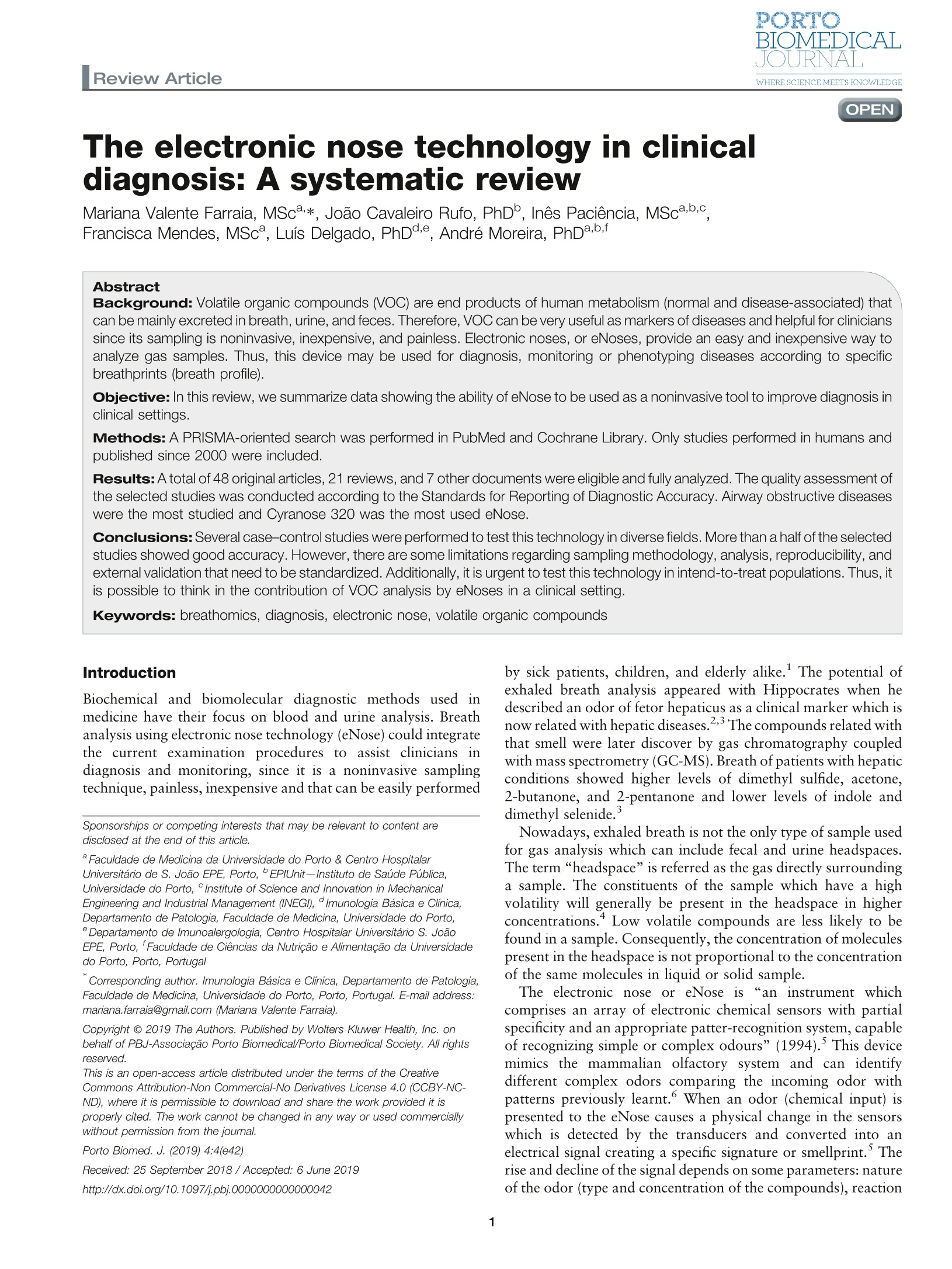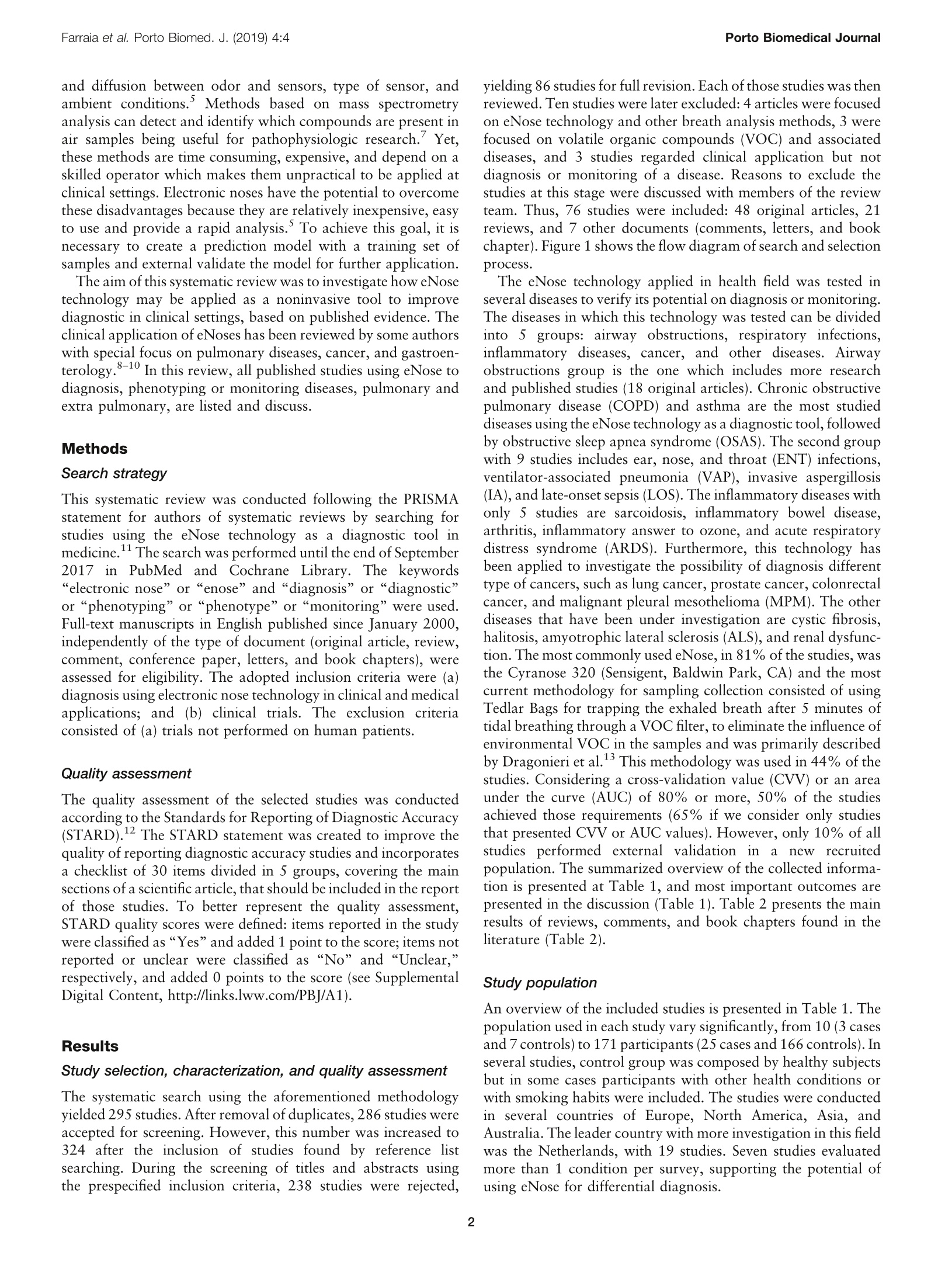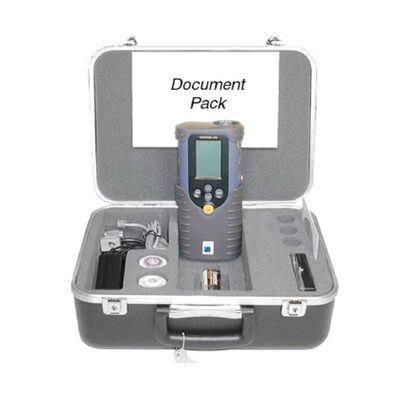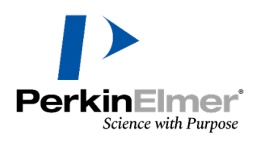方案详情文
智能文字提取功能测试中
PORTOBIOMEDICALJOURNALWHERE SCIENCE MEETS KNOWLEDGEReview Article Porto Biomedical JournalFarraia et al. Porto Biomed.J. (2019) 4:4 The electronic nose technology in clinicaldiagnosis: A systematic review Mariana Valente Farraia, MSca*, Joao Cavaleiro Rufo, PhD, Ines Paciencia, MScab,c, Francisca Mendes, MSc, Luis Delgado, PhDde, Andre Moreira, PhDa.of Abstract Background: Volatile organic compounds (VOC) are end products of human metabolism (normal and disease-associated) thatcan be mainly excreted in breath, urine, and feces. Therefore, VOC can be very useful as markers of diseases and helpful for clinicianssince its sampling is noninvasive, inexpensive, and painless. Electronic noses, or eNoses, provide an easy and inexpensive way toanalyze gas samples. Thus, this device may be used for diagnosis, monitoring or phenotyping diseases according to specificbreathprints (breath profile). Objective: In this review, we summarize data showing the ability of eNose to be used as a noninvasive tool to improve diagnosis inclinical settings. Methods: A PRISMA-oriented search was performed in PubMed and Cochrane Library. Only studies performed in humans andpublished since 2000 were included. Results:Atotal of 48 original articles, 21 reviews, and 7 other documents were eligible and fully analyzed. The quality assessment ofthe selected studies was conducted according to the Standards for Reporting of Diagnostic Accuracy. Airway obstructive diseaseswere the most studied and Cyranose 320 was the most used eNose. Conclusions: Several case-control studies were performed to test this technology in diverse fields. More than a half of the selectedstudies showed good accuracy. However, there are some limitations regarding sampling methodology, analysis, reproducibility,andexternal validation that need to be standardized.Additionally, it is urgent to test this technology in intend-to-treat populations. Thus, itis possible to think in the contribution of VOC analysis by eNoses in a clinical setting. Keywords: breathomics, diagnosis, electronic nose, volatile organic compounds Introduction Biochemical and biomolecular diagnostic methods used inmedicine have their focus on blood and urine analysis. Breathanalysis using electronic nose technology (eNose) could integratethe current examination procedures to assist clinicians indiagnosis and monitoring, since it is a noninvasive samplingtechnique, painless, inexpensive and that can be easily performed Sponsorships or competing interests that may be relevant to content aredisclosed at the end of this article. Faculdade de Medicina da Universidade do Porto & Centro HospitalarUniversitario de S. Joao EPE, Porto, EPlUnit-Instituto de Saúde Publica,Universidade do Porto, Institute of Science and Innovation in MechanicalEngineering and Industrial Management (INEGI),Imunologia Basica e Clinica,Departamento de Patologia, Faculdade de Medicina, Universidade do Porto,Departamento de Imunoalergologia, Centro Hospitalar Universitario S. JoaoEPE, Porto, Faculdade de Ciencias da Nutricaoe Alimentacao da Universidade do Porto, Porto, PortugalCorresponding author. Imunologia Basica e Clinica, Departamento de Patologia,Faculdade de Medicina, Universidade do Porto, Porto, Portugal. E-mail address:mariana.farraia@gmail.com (Mariana Valente Farraia).Copyright ◎ 2019 The Authors. Published by Wolters Kluwer Health, Inc. onbehalf of PBJ-Associacao Porto Biomedical/Porto Biomedical Society. All rightsreserved.This is an open-access article distributed under the terms of the Creative Commons Attribution-Non Commercial-No Derivatives License 4.0 (CCBY-NC-ND), where it is permissible to download and share the work provided it isproperly cited. The work cannot be changed in any way or used commerciallywithout permission from the journal. Porto Biomed. J. (2019) 4:4(e42) Received: 25 September 2018 / Accepted:6 June 2019 by sick patients, children, and elderly alike. The potential ofexhaled breath analysis appeared with Hippocrates when hedescribed an odor of fetor hepaticus as a clinical marker which isnow related with hepatic diseases.The compounds related withthat smell were later discover by gas chromatography coupledwith mass spectrometry (GC-MS). Breath of patients with hepaticconditions showed higher levels of dimethyl sulfide, acetone,2-butanone, and 2-pentanone and lower levels of indole anddimethyl selenide.' Nowadays, exhaled breath is not the only type of sample usedfor gas analysis which can include fecal and urine headspaces.The term "headspace"is referred as the gas directly surroundinga sample. The constituents of the sample which have a highvolatility will generally be present in the headspace in higherconcentrations. Low volatile compounds are less likely to befound in a sample. Consequently, the concentration of moleculespresent in the headspace is not proportional to the concentrationof the same molecules in liquid or solid sample. The electronic nose or eNose iss“an instrument whichcomprises an array of electronic chemical sensors with partialspecificity and an appropriate patter-recognition system, capableof recognizing simple or complex odours”(1994).’ This devicemimics the mammalian olfactory system and can identifydifferent complex odors comparing the incoming odor withpatterns previously learnt. When an odor (chemical input) ispresented to the eNose causes a physical change in the sensorswhich is detected by the transducers and converted into anelectrical signal creating a specific signature or smellprint. Therise and decline of the signal depends on some parameters: natureof the odor (type and concentration of the compounds), reaction and diffusion between odor and sensors, type of sensor, andambient conditions5. MNethods based on mass spectrometryanalysis can detect and identify which compounds are present inair samples being useful for pathophysiologic research. Yet,these methods are time consuming, expensive, and depend on askilled operator which makes them unpractical to be applied atclinical settings. Electronic noses have the potential to overcomethese disadvantages because they are relatively inexpensive, easyto use and provide a rapid analysis.To achieve this goal, it isnecessary to create a prediction model with a training set ofsamples and external validate the model for further application. The aim of this systematic review was to investigate how eNosetechnology may be applied as a noninvasive tool to improvediagnostic in clinical settings, based on published evidence. Theclinical application of eNoses has been reviewed by some authorswith special focus on pulmonary diseases, cancer, and gastroen-terology.8-10 In this review, all published studies using eNose todiagnosis, phenotyping or monitoring diseases, pulmonary andextra pulmonary, are listed and discuss.S. Methods Search strategy This systematic review was conducted following the PRISMAstatement for authors of systematic reviews by searching forstudies using the eNose technology as a diagnostic tool inmedicine.The search was performed until the end of September2017 iniIPubMed and CochraneLibrary. The keywords“electronic nose”or “enose"and“diagnosis”or“diagnostic”or “phenotyping”or “phenotype”or“monitoring”were used.Full-text manuscripts in English published since January 2000,independently of the type of document (original article, review,comment, conference paper, letters, and book chapters), wereassessed for eligibility. The adopted inclusion criteria were (a)diagnosis using electronic nose technology in clinical and medicalapplications; and (b) clinical trials. The exclusion criteriaconsisted of (a) trials not performed on human patients. Quality assessment The quality assessment of the selected studies was conductedaccording to the Standards for Reporting of Diagnostic Accuracy(STARD).12 The STARD statement was created to improve thequality of reporting diagnostic accuracy studies and incorporatesa checklist of 30 items divided in 5 groups, covering the mainsections of a scientific article, that should be included in the reportof those studies. To better represent the quality assessment,STARD quality scores were defined: items reported in the studywere classified as “Yes"and added 1 point to the score; items notreported or unclear were classified as “No”and “Unclear,"respectively, and added 0 points to the score (see SupplementalDigital Content, http://links.lww.com/PBJ/A1). Results Study selection, characterization, and quality assessment The systematic search using the aforementioned methodologyyielded 295 studies. After removal of duplicates, 286 studies wereaccepted for screening. However, this number was increased to324 after the inclusion of studies found by reference listsearching. During the screening of titles and abstracts usingthe prespecified inclusion criteria,238 studies were rejected, yielding 86 studies for full revision. Each of those studies was thenreviewed.Ten studies were later excluded: 4 articles were focusedon eNose technology and other breath analysis methods, 3 werefocused on volatile organic compounds (VOC) and associateddiseases, and 3 studies regarded clinical application but notdiagnosis or monitoring of a disease. Reasons to exclude thestudies at this stage were discussed with members of the reviewteam. Thus, 76 studies were included: 48 original articles, 21reviews, and 7 other documents (comments, letters, and bookchapter). Figure 1 shows the flow diagram of search and selectionprocess. The eNose technology applied in health field was tested inseveral diseases to verify its potential on diagnosis or monitoring.The diseases in which this technology was tested can be dividedinto 5groups: airway obstructions, respiratory infections,inflammatory diseases, cancer, and other diseaseis.. Airwayobstructions group is the one which includes more researchand published studies (18 original articles). Chronic obstructivepulmonary disease (COPD) and asthma are the most studieddiseases using the eNose technology as a diagnostic tool, followedby obstructive sleep apnea syndrome (OSAS). The second groupwith 9 studies includes ear, nose, and throat (ENT) infections,ventilator-associated pneumonia (VAP), invasive aspergillosis(IA), and late-onset sepsis (LOS). The inflammatory diseases withonly 5 studies are sarcoidosis, inflammatory bowel disease,arthritis, inflammatory answer to ozone, and acute respiratorydistress syndrome (ARDS). Furthermore, this technology hasbeen applied to investigate the possibility of diagnosis differenttype of cancers, such as lung cancer, prostate cancer, colonrectalcancer, and malignant pleural mesothelioma (MPM). The otherdiseases that have been under investigation are cystic fibrosis,halitosis, amyotrophic lateral sclerosis (ALS), and renal dysfunc-tion.The most commonly used eNose, in 81% of the studies, wasthe Cyranose 320 (Sensigent, Baldwin Park, CA) and the mostcurrent methodology for sampling collection consisted of usingTedlar Bags for trapping the exhaled breath after 5 minutes oftidal breathing through a VOC filter, to eliminate the influence ofenvironmental VOC in the samples and was primarily describedby Dragonieri et al. This methodology was used in 44% of thestudies. Considering a cross-validation value (CVV) or an areaunder the curve (AUC) of 80% or more, 50% of the studiesachieved those requirements (65% if we consider only studiesthat presented CVV or AUC values). However, only 10% of allstudies performed external validation in a new recruitedpopulation. The summarized overview of the collected informa-tion is presented at Table 1, and most important outcomes arepresented in the discussion (Table 1). Table 2 presents the mainresults of reviews, comments, and book chapters found in theliterature (Table 2). Study population An overview of the included studies is presented in Table 1. Thepopulation used in each study vary significantly, from 10 (3 casesand 7 controls) to 171 participants (25 cases and 166 controls). Inseveral studies, control group was composed by healthy subjectsbut in some cases participants with other health conditions orwith smoking habits were included. The studies were conductedin several countries of Europe, North America, Asia, andAustralia. The leader country with more investigation in this fieldwas the Netherlands, with 19 studies. Seven studies evaluatedmore than 1 condition per survey, supporting the potential ofusing eNose for differential diagnosis. Discussion Diagnosis of airway obstructive diseases The present review study presents an overview of eNoseperformance on diagnosis and phenotyping of diseases. Mostof the included studies (18 original articles) concerned commonairway obstructive diseases, such as COPD and asthma, and theVOC patterns were analyzed to differentiate these conditions, orto compare them with breathprints of other airway diseases, suchas lung cancer. Dragonieri et al found that COPD and nonsmall cell lungcancer have different exhaled VOC patterns which could bedistinguished by eNose with a CVV of 85%.4 Furthermore,patients with nonsmall cell lung cancer could also be distin-guished from healthy controls with a CVV of 80% or 90% when duplicates measurements were analyzed. At the same year, Fenset al published a study aiming to separate VOC profiles betweenCOPD and asthma patients. They found different breathprofiles between asthma subjects and COPD patients with anaccuracy of 96%,as well as between nonsmoking controls andsmoking controls with accuracies values of 95% and 92.5%,respectively. Later, the same group of authors conducted a studyto externally validate the previous results, following STARDguidelines.16 The external validity of breath profiles showed thatfixed asthma and classic asthma can be discriminated fromCOPD patients with high accuracy (88% and 83%, respectively)and sensitivity and specificity values varied from 85% up to 91%and 90%,respectively. Fens et al were able to differentiate mildand moderate types of COPD not only using eNose technologybut also using mass spectrometry (GC-MS) and computed aui jo%88 U! 10oJoo seMesoNe ieyi puno seM 1! %88 Mo Table 1 pue sisoubeip/6ojoigojoiw yim peedwoo aem sjuudyeejg oze esoueo suopooju! N3 4i sjuened 06 (continued). M0 Table 1 AATD=alpha 1-antitrypsin deficiency, AC=Aspergillus fumigatus colonization, ALS=amyotrophic lateral sclerosis, ARDS=acute respiratory distress syndrome, ARDs=asbestos-related diseases, AUC=area under the ROC curve, BAL=bronchoalveolar lavage, BC=bacterialcolonization, BCa=bladder cancer, CD=Crohn disease, CF =cystic fibrosis, COPD=chronic obstructive pulmonary disease, CPI=chronic pulmonary Pseudomonas aeruginosa infection, CRC=colorectal cancer,CW=cross-validation value, EB=exhaled breath, EBC=exhaled breathcondensate, eNose=electronic nose, ENT=ear, nose, and throat, FeNO =fractional exhaled nitric oxide, GC-MS= gas chromatography coupled to mass spectrometry, GOLD=global initiative for chronic obstructive lung disease, GORD=gastroesophageal reflux disease, IA=invasiveaspergillosis, IBD= inflammatory bowel disease, ICS =inhaled corticosteroid,LOS=late-onset sepsis, MM=malignant mesothelioma, MPM = malignant pleural mesothelioma, OSAS=obstructive sleep apnea syndrome, OVS=overlap syndrome, PCD=primary ciliary dyskinesia, PsA=psoriatic arthritis, RA=rheumatoid arthritis, ROC=receiver operating characteristic, UC=ulcerative colitis, VAP=ventilator associated pneumonia, VOC=volatile organic compounds. Characteristics and main results of the included studies (reviews,comments, and book chapters)aType ofRef. Year document Objectives Conclusions61 o 2000 Review Discuss current status of electronic nose technology and its link to medicine The diagnostic power of odors is a very old practice which is being rediscoveredodue to new advances in gas sensor technology and artificial intelligence62 2004 Review Describe and evaluate electronic olfaction technology to monitor the presence of Despite the potential advantages of electronic olfaction blood glucose, monitoringVOC from human body and b3reath that can be used to evaluate status of remains the major method for monitoring glycemic status in diabetesdiabetes63 2004 Review Present an overview of the most important recent developments, illustrates some The development of robust instrumentation, coupled with remote data acquisitionapplications for the diagnosis of infections and discusses future trends and central processing powered by hybrid intelligence systems, could see eNoseotechnology in common use in the next 5 years64 2005 Book chapter Bronchogenic carcinoma diagnosis The exhaled breath of patients with lung cancer has distinct characteristics thatcan be identified with an eNose65 2010 Review eNose as a diagnostic tool in otolaryngology eNose technology holds significant potential for enabling rapid, noninvasive,bedside diagnosis of otolaryngologic disease66 2011 Review To review the fast-developing topic of assessment of exhaled breath components Examination of exhaled breath has the potential to change the existing routineto improve the diagnosis and monitoring of respiratory and systemic diseases approaches in human medicine67 2011 Review Specific profiles of volatile compounds in exhaled breath and metabolites in EBC eNose and NMR-based metabolomics of EBC can distinguish patients withare potentially useful markers of inflammatory respiratory diseases respiratory diseases such as asthma, COPD, and lung cancer, or diseases witha clinically relevant respiratory component including cystic fibrosis and primaryciliary dyskinesia, and healthy individuals68 2011 Review Summarize the major eNose technologies developed for healthcare and biomedical There are several current limitations that have hindered the development of eNoseapplications since the late 1980s medical applications in the medical industry. One major problem is that therehas not been sufficient trial in-hospital testing of eNose instruments todetermine the capabilities, feasibility, and performance of these instruments forspecific tasks69 2011 Comment Should we replace mammalian scent detection with a machine or return toteaching physicians to sniff?70 2012 Review Techniques potentially useful for identifying biomarkers of pulmonary inflammation Different techniques could enable an early identification of subgroups of healthyand oxidative stress smokers at higher risk for tobacco-induced lung damage. eNose differentiateshealthy smokers from healthy nonsmokers based on breath VOC patterns71 2013 Review Describe the current status on clinical validation and application of breath analysis Several proofs of concept studies have shown promising results for diagnosingby eNose in the diagnosis and monitoring of chronic airways diseases different (airway) diseases, but there are still a lot of limitations72 2013 Editorial Review breathomics in sleep apnea Taken together, composite metabolomics analysis of exhaled breath can becomean aid in the diagnostic work-up and monitoring of OSAS, similar toinflammatory airways diseases73 2013 Editorial What method would you use to identify asthma in a symptomatic patient, and how So far, no single indicator has been identified as definitive of asthma, and patternwould you attempt to predict treatment response? recognition approaches have promising properties. Following larger populationstudies and further technological advances, the eNose certainly has the potentialto become a good tracker of asthma, initially in the hands of researchers andperhaps in the longer term also in clinical practice74 2013 Letter to editor eNose can detect changes in exhaled breath molecular profiles during the In conclusion, in this small study we did not find an association between theendovenous laser ablation (EVLA) procedure breathprints and changes of perceived taste or smell.75 2014 Review Cover various upper and lower airway sampling methods eNose and breath condensate have potential biomarker application but still requireostandardization and additional study10o 2014 Review Review current sensor instruments and their application in the detection of gas Gas phase volatile compound biomarkers offer the potential for future diagnosticsphase volatile compound biomarkers in medicinefocusing on gastroenterology in gastroenterology. The eNose stands up to the challenge as evidence mountsoin favor of its support376 2014 Review Analyze the limitations of traditional imaging techniques in the early detection of The analysis of breath VOC is a choice for the early detection of lung cancerlung cancer, illustrate possible mechanisms of the production of VOC in compared to imaging techniques. We recommend a more comprehensivecancerous cells, present evidence that supports the detection of such disease technique that integrates the analysis of VOC and non-VOC in breath. Inaoddition, VOCs in urine may also be a trend in research on the early detection the biological material used, and different VOC identified tomography scanning. Interestingly, the group found thateNose breathprints could be related with activation markers ofeosinophils and neutrophils in mild asthma, suggesting that theeNose may not only be useful for asthma diagnosis, but also forphenotyping. Another successful application of the eNose wasdemonstrated in a study where individuals with COPD werediscriminated according to their alpha 1-antitrypsin deficiency.The eNose was also able to discriminate COPD patients with andwithout airway bacterial colonization or identify the presence ofa viral or bacterial cause in acute exacerbations.20,21 However, the first study using breathprint analysis of exhaledVOC by an eNose in airway obstructions was conducted inpatients with mild and severe asthma.In this study, the degreeof asthma severity was not discriminated by eNose, although itwas able to distinguish asthma patients from controls with anaccuracy of 90%. These results were further confirmed byanother group and a sensitivity of 80% was reached, despite thelow specificity of 65%.24 These results can be explained by thedifferences in methodologies, namely due to the effects oftreatment that was ddiscontinued in one of the studies.Nevertheless, changes in the airway caliber in asthma have beenshown to not affect the breathprints.23 A recent study involvingasthmatic subjects was conducted in Spain and aimed tophenotype the disease using the eNose.25 The eNose was ableto differentiate inflammatory phenotypes (eosinophilic, neutro-philic, and paucigranulocytic) in patients with persistent asthmawith sensitivities and specificities ranging from 55% up to 94%and 79% up to 87%, respectively. Exhaled breath profiles ofpatients with asthma were also evaluated in a longitudinal studyusing 2 different approaches to analyze breath samples (GC-MSand eNose).26 Both technologies were able to distinguishbreathprints of patients collected during baseline, loss of control,and during recovery time. eNose technology had a higheraccuracy than mass(Sspectrometry (86-95%and 68-77%,respectively). OSAS was primarily investigated by Benedek et al thatdiscovered the potential of the eNose technology in discriminat-ing OSAS from non-OSAS patients in a pediatric population(sensitivity: 78%, specificity: 70%, AUC: 0.80).28 These resultsare similar to those reported by Greulich et al (sensitivity: 93%,specificity: 70%, AUC: 0.85).2 Obesity was also found to affectthe pattern of exhaled breath since obese patients with OSASWerediscriminated from health controls (cross validationaccuracy [CVA]: 97.4%), but were only moderate distinct fromobese patients without OSAS (CVA: 67.6%).3In a pilot study,OSAS breathprints were compared to OVS (overlap syndrome)and COPD.Patients with OSAS clustered distinctly from thosewith OVS as well as from those with COPD (AUC: 1.00 and0.83), but patients with OVS were not significantly different fromthose with COPD (AUC: 0.60). The significant interest of researchers in studying eNosetechnology as a diagnosis tool is notable, especially concerningairway obstructive diseases. Clinical diagnosis can be difficultbecause of related symptoms between different diseases, whichmakes breathprint analysis very useful if further researchconfirms these primary results. Diagnosis is not the onlyapplication of breathprint analysis, as it also appears to bepromising for the phenotyping and monitoring of diseases. Diagnosis of infectious diseases Infectious diseases are caused by pathogenic microorganisms thatare known to produce specific VOC. Several groups hypothesized that eNose could be used as a noninvasive tool to identify specificsignatures of these health conditions. The most studied condition was VAP, a type of lung infection.A group in the United States discovers that Cyranose 320 wascapable to correlate different breathprints to a pneumoniascore.4 However, it was Schnabel et al that presented a moredetailed study revealing a sensitivity of 88%and a specificity of66% in the discrimination between VAP patients with a positivebronchoalveolar lavage test and healthy controls. ENT infections are very common and the eNose technology, ina preliminary study with 90 patients, was able to identify thepresence of bacterial infections in 88.2% of the cases.40 Thisresult was also obtained by Dutta et al that, additionally, wascapable to distinguish between 3 classes of Staphylococcus aureusinfections (MRSA, MSSA, and C-NS).41 A more specific studywas conducted in patients with a positive diagnosis for bacterialsinusitis.42 The eNose could predict the diagnosis of sinusitis in atleast 72% of the samples using the externalal validationmethodology. However, no further studies aiming to predictENT infections by eNose in patients were conducted since 2006. The most recent studies focused on diagnosis of IA and theprediction of LOS at a preclinical stage.54,56 In the first one,eNose could established distinct VOC profile in patients with IAand controls with an AUC of 0.93.54 In the last one, fecal VOCprofile of preterm infants with LOS was discriminated frommatched controls with a reasonable AUC of 0.70.56 Microorganisms produce different VOC that can be detected inair samples by eNose. These studies showed that exhaled breathcan be analyzed by eNose, but also fecal gas which showeddistinct VOC profiles. The results are promising but furtherinvestigation is required. Diagnosis of inflammatory diseases There is some recent research in this field; however, the number ofstudies is still low. Dragonieri et al started to study sarcoidosis in11 untreated patients, 20 treated pulmonary sarcoidosis patientsand 25 healthy controls.4 Patients with untreated sarcoidosiswere distinguished from healthy controls with an AUC of 0.825and a CVA of 83.3%. This number decreased when breathprintsof untreated patients were compared with the treated group(CVA: 74.2%). ARDS was also a condition investigated in 58patients and 92 controls.48 The 2 groups were separated with anAUC of 0.71. Differential diagnosis of Crohn disease andulcerative colitis yielded a promising result in a pediatricpopulation during active and remissive disease. The valuesof sensitivity and specificity varied from 88% up to 100% and67% up to 100%, respectively. The eNose was also tested inrheumatoid arthritis and psoriatic arthritis yielded moderate topoor values of sensitivity and specificity. Inflammatory diseases are less investigated, and more studies arerequired to confirm the aforementioned observations. Neverthe-less, these results are promising, especially for sarcoidosis. Diagnosis of cancer More recently, the eNose technology has been tested to diagnosesome types of cancer. Surprisingly, lung cancer was not the firstresearch target. An Australian group reported that, in 88% of thecases, eNose could separate MPM patients from controls.These results were similar to another study performed byDragonieri et al.Both studies included patients with significantasbestos exposure but without MPM to compare with the MPM group. MPM subjects could be discriminated from those withasbestos exposure (sensitivity: 92.3%, specificity: 85.7%, AUC:0.917) and from controls (sensitivity: 92.3%, specificity:69.2%,AUC: 0.893).3 Lung cancer was then explored by McWilliamset al and it was found that in 80% of the cases, eNosemeasurements were able to distinguish lung cancer patients fromhigh-risk smoking control subjects without cancer.TTheseresults were similar to a previous study where eNose reached aperformance of 80% of sensitivity and 48% of specificity. Pilot studies in prostate, bladder, and colonrectal cancer usingthe air scape of urine and feces samples for analysis wereconducted recently.50-52 The ChemPro 100-eNose could dis-criminate prostate cancer and benign prostatic hyperplasia withmoderate values of sensitivity and specificity of 78% and 67%,respectively.2Electronic nose could also separate bladder cancerand patients with benign urological condition with moderate togood sensitivity and specificity (75% and 86%, respectively).Finally, Cyranose 320 was able to distinguish the fecal gas profileof 40 patients with colonrectal cancer, 60 patients with advancedadenomas, and 57 healthy controls. Sensitivity and specificityvaried from 62% up to 85% and 73% up to 87%. Cancer diagnosis using air analysis of exhaled breath, urine,and fecal samples is a recent focus of investigation, revealingpromising results. Although cancers related to the respiratorysystem have been further studied, only pilot studies have beenperformed so far, and a validation of these results is still required. Other diseases The diagnosis by eNose was also applied to differentiatebreathprints of cystic fibrosis (CF) and primary ciliary dyskinesia(PCD) patients in2 (different studies, showing differentresults.45,46The first reached a sensitivity of 84% and aspecificity of 60%, when breathprints of both diseases werecompared. Comparing both diseases with control group, similarresults were observed (sensitivity: 88% and 84%; specificity:52% and 60%).45 The other study did not compare the 2diseases.46 Comparisons between CF or PCD and the controlgroup showed a lower sensitivity when compared to the previousstudy (50% and 57%, respectively) but with a higher specificity(95% and 85%, respectively). The samples were analyzed withCyranose 320 and both used a VOC filter to minimize theinfluence of environmental VOC on the breath profiles. Themajor difference was among the population, the first usedchildren’s breathing samples, while the last studied samples fromyoung adults. Only 1 study evaluated the capacity of eNose to separatehealthy subjects from patients with renal failure, yielding acorrect classification of95.2%.55 However, a completelydifferent methodology was used. Authors investigated bodyodor with the sensor head on the leg of patients. More recently,ALS was also investigated and breath profiles from patients weremoderately discriminated from healthy controls (CVA: 75%).Finally, oral malodor was assessed, and an AUC of 0.879 wasreached comparing control subjects and malodor patients. This technology can be explored and investigated to diagnoseseveral diseases. Further research in other health conditions isexpected to test the potential use of this diagnostic tool. Limitations There are some limitations in studies using eNose technology as apossible noninvasive diagnosis tool. The most evident is that eNose cannot identify and quantify the compounds present in thesample. Electronic noses are used to detect patterns and notindividual molecules. Some studies have demonstrated anassociation between the eNose technology and mass spectrome-try, yielding a more complete analysis.17,18 However, breathprintanalysis allows the quick and easy assessment of an exhaledbreath sample with thousands of volatile molecules. Anotherlimitation is related to exhale breath sampling since exogenousVOC can be present in samples. Breathprints are criticallydependent on the methods of collection and sampling of exhaledbreath. The most commonly used technique was described byDragonieri et al.13 Sample collection consists of asking patients tobreath normally for 5 minutes through a 3-way nonrebreathingvalve with a VOC filter at the inspiratory port and a silica filter atthe expiratory port to promote inspiratory VOC filtering and airdrying, respectively. Therefore, it is possible to minimize anyinfluence of humidity and environmental VOC on exhaled VOCpatterns. 13,15 After a maximal deep inspiration, patients exhaleda single vital capacity volume into a 10 L Tedlar bag connected tothe expiratory port and silica reservoir. Almost 50% of thestudies described in this review used this sampling methodology.In addition to this method, researchers should also adopt arestrict protocol regarding to food and beverage intake prior tosampling. Sampling methods should be standardized to achievecomparable results between studies and to improve diagnosticaccuracy. As a pioneer area, much of research involves pilot studies toevaluate the potential of eNose to discriminate breathprints ofcontrols from patients with a specific disease. However, in theairway obstructions group, there are some recent studies that tryto distinguish different stages and severities of a disease (mainlyCOPD and asthma).17.25 This type of research is expected toincrease once its clinical application becomes more evident, aswell as studies to help in treatment management and guidance oftherapies. The external validation allows to confirm and providerobustness to the obtained results. Unfortunately, only 5 studiesperformed external validation. External validation requires atraining set and a validation set with newly recruited patients toassess the diagnostic accuracy. In the future, this validationmethodology should be more recurrent to give strength to theresults and introduce this tool into real clinical practice.Additionally, STARD guidelines for diagnostic accuracy studiesshould be followed to increase transparency and strength ofresults. There are some limitations regarding to the methodology thatshould be solved to enable comparisons of results across studies.Still, it is necessary to do studies in larger populations to achieverobust results and include pediatric subjects, not just adults. Future perspectives In the future, research in this field is expected to increase due tothe promising results demonstrated in previous studies, especiallyin airway obstructive diseases. The main objective is to achieve auniversal methodology, with adequate reproducibility andrepeatability, to enable comparisons between studies. Externalvalidation should be performed to increase robustness of theresults. Subsequently, studies on larger, representative, andintend-to-treat populations are needed to evaluate this technolo-gy in a real clinical setting in the presence of several confounders.It should be emphasized that pediatric population must beincluded in further studies. Thereby, it is possible to think about a clinical application of eNose technology, firstly as a complemen-tary diagnostic approach for other traditional tools. Conclusions In conclusion, there is a need for a simple, noninvasive,inexpensive, and easy-to-perform technique to assess complexbiological samples. GC-MS studies already proven that airanalysis, especially of exhaled breath, can be a tool to evaluate anindividual’s metabolic status (normal or disease-associated). Inrecent years, several studies using eNose technology to analyzegas samples have shown promising results to diagnose differentdiseases, not only respiratory but also infectious and inflamma-tory diseases and various types of cancers. Electronic noseanalysis could be useful in a clinical setting because they areportable, easy to perform, inexpensive, rapid and do not require aspecialized technician. Many of the previous studies have shownthe moderate to good accuracy of this technology to differentiateseveral conditions from controls, especially airway obstructivediseases. However, it is a priority to create guidelines forstandardized breath sampling, analysis and interpretation of theresults. Additionally, it is necessary to externally validate theresults in independent datasets of newly recruited patients tostrengthen the results. Finally, studies on larger and representa-tive populations are needed to test this technology in a realclinical setting. Reproducibility and repeatability of measure-ments using eNoses should also be studied and optimized toensure comparable results. Acknowledgments The authors gratefully acknowledge funding from ProjectNORTE-01-0145-FEDER-000010-Health, Comfort and Ener-gy in the Built Environment (HEBE), cofinanced by ProgramaOperacional Regional do Norte (NORTE2020), through FundoEuropeu de Desenvolvimento Regional (FEDER). The current work has been supported by the EXPOSE project,which is financed by FEDER/FNR and by Fundacao para aCiencia e Tecnologia (EXPOSE 02/SAICT/2016-Project no.023222). Conflicts of interest The authors declare no conflicts of interest. References ( [1] Boots AW, B o s L D , van de r Schee MP , et al. Exh a l ed m o l e cularfingerprinting in diagnosis and monitoring: v a lidating v o latile promises. T rends Mol Med. 2015;21:633-644. ) ( [2] Risby T H, Solga SF. Current status o f clinical breath analysis. Appl Phys B. 2006;85:421-426. ) ( [ 3 ] Vandenvelde S , N e vens F, Vanhee P, e t al . GC-MS analysis of b r eath odor compounds in liver patients. J Chromatogr B . 2008;875:344-348. ) ( [4] Wahl H G, H o ffmann A, L uf t D, et a l. An a lysis of vo l atile o r ganic compounds in h uman u r ine by headspace g as chromatography-massspectrometry witha multipurposesampler. J C hromatogr A. 1999;847:117-125. ) [5] Gardner JW, Bartlett PN. A brief history of electronic noses. SensActuators B Chem. 1994;18:210-211. ( [6] Persaud K, D odd G . Analysis of discrimination m e chanisms in th e mammalian ol factory s ystem u sing a model nose. Nature. 1 9 82;299:352-355. ) ( [7] Van B erkel JJBN, D a llinga J W , Moller GM, et al. A pro f ile of volatileorganic compounds i n b r eath discriminates C OPD pa t ients f r om controls.Respir Med. 2010;104:557-563. ) [8] Bos LD, Sterk PJ, Fowler SJ. Breathomics in the setting of asthma andchronic obstructive pulmonary disease. J Allergy Clin Immunol.2016;138:970-976. ( [ 9] Krilaviciute A, Heiss JA, Leja M, et a l . D e tection o f cancer th r ough e xhaled breath: a systematic review. Oncotarget. 2015;6:38643-38657. ) ( [10] Arasaradnam RP, Covington JA, Harmston C, et al. R eview article: Next generation diagnostic modalities in gastroenterology-gas phase volatile compound biomarker d etection. Aliment Pharmacol Ther. 2014;39:780-789. ) ( [1 1 ] M oher D , Lib e rati A, Tetzlaff J, e t a l. Preferred reporting it e ms forsystematic reviews and meta-analyses : th e PRISM A s tatement. PLoS Med. 2009;6:e1000097. ) ( [12] Bossuyt PM, Reitsma JB, Bruns DE, et al. ST A RD 2015: an updated listof e ssential items for reporting diagnostic accuracy studies . BMJ. 2015;351:h5527. ) ( [13] Dragonieri S, Schot R , M ertens B J A, e t a l . An e l ectronic n ose in t hediscrimination of patients with asthma and c o ntrols. J Allergy Clin I mmunol. 2 007;120:856-862. ) ( [14] D ragonieri S , A n nema JT, Schot R, et al. An e lec t ronic nose in thediscrimination o f patie n ts with non-small cell lung cancer a nd COPD. Lung C ancer. 2009;64:166- 1 70. ) ( [15] Fens N, Zwinderman AH, van der Schee M P , et a l . E xhaled breathprofiling enables discrimination o f c hronic obstructive pulmonarydisease and d asthma. Am J R espir Crit C are M ed. 2009;180: 1 076-1082. ) ( [ 1 6] Fens N , R oldaan A C , va n der Sc h ee MP, et a l. Ex t ernal va l idation ofexhaled b r eath profiling using an electronic nose in the discrimination ofasthma w ith f i xed a i rways ob s truction a n d ch r onic obs t ructive p ulmonary disease. Cli n E xp A l lergy. 2 011;41:1371-1378. ) ( [17] F ens N, d e N i js SB , Peters S, e t a l . Exhaled air molecular p rofiling in r elation to inflammatory s ubtype a nd activity in COPD. E u r R e spir J. 2011;38:1301-1309. ) ( [ 1 8] Fens N, van Rossum AG J , Zanen P, e t al. Subphenotypes of mild-to-moderate COPD by factor and cluster analysis of pulmonary function,CT imaging a n d breathomics in a population-based su r vey. COPD. 2013;10:277-285. ) ( [19] Hattesohl A DM, Jorres RA, Dressel H, et al . D i scrimination between C OPD patients with and without alpha 1-antitrypsin deficiency using an e lectronic nose. Off J Asian Soc R espirol. 2011;16:1258-12 6 4 . ) ( [20] Sibila O, G arcia-Bellmunt L , G iner J, et al. I d entification o f airwaybacterial colonization b y an el e ctronic no s e in chr o nic obstructivepulmonary disease. Respir Med. 2014;108:1608-1614. ) ( [21] | van Geffen WH, B ruins M, K erstjens HAM. D i agnosing viral andbacterial respirator y infectio n s in acu t e COPD exacerbations by anelectronic n ose: a p ilot study. J Breath R es. 2 016;10:036001. ) ( [22] ] 1 Timms C, Thomas PS, Yates DH. D etection of gastro-oesophageal refluxdisease (GORD) in p at ients wi t h obstructive lung disease using exhaledbreath profiling. J Breath Res [ Internet] . 2012;6: [cited 2017 Sep 1 1]. A vailable f rom: h t tp://stacks.iop.org/ 1 752-7163/6/i=1/a=016003?key= crossre f .27660ac0c7241890bceec41e534d21a7. ) ( [2 3 ] L a zar Z , F e ns N , Maten J, e t a l. Ele c tronic no s e br e a thprints areindependent of a c ute c h anges in airway caliber in as t hma. Sen s ors. 2010;10:9127-91 3 8. ) ( [24] van d er S chee M P, P a lmay R, Co w an JO, e t al. P redicting steroid responsiveness i n patients with a s thma us i ng exhaled breath prof i ling. C lin Exp A llergy. 2013;43:1217-1225. ) ( [25] Plaza V, Crespo A , G iner J, e t al. Inflammatory asthma p henotypediscrimination u sing a n e l ectronic nose breath an a lyzer. J I nvestig A llergol Clin Immunol. 2015;25:431-43 7 . ) ( [26] B rinkman P, van de Pol MA, G erritsen MG, et al. Exhaled breath profilesin the monitoring of loss of control and clinical recovery in a s thma. Cl i n E xp A llergy. 2017;47:1159-1169. ) ( [27] S aidi T, Tahri K, El Bari N, et al. Det e ction of seasonal allergic rhinitis f rom exhaled breath VOCs using an electronic n o se based o n a n a r ray ofchemical sensors. IEEE S ensors. 2015;1566-156 9 . South Ko r ea. ) [28] Benedek P, Lazár Z, Bikov A, et al. Exhaled biomarker pattern is alteredin children with obstructive sleep apnoea syndrome. Int J PediatrOtorhinolaryngol. 2013;77:1244-1247. [29] Greulich T, Hattesohl A, Grabisch A, et al. Detection of obstructive sleepapnoea by an electronic nose. Eur Respir J. 2013;42:145-155. [30] Dragonieri S, Porcelli F, Longobardi F, et al. An electronic nose in thediscrimination of obese patients with and without obstructive sleepapnoea. J Breath Res. 2015;9:026005. [31] Dragonieri S, Quaranta VN, Carratu P, et al. Exhaled breath profiling inpatients with COPD and OSA overlap syndrome: a pilot study. J BreathRes. 2016;10:041001. ( [32] H ockstein N G , Thaler ER , Tori g ian D, et al. Diagnosis of pneumonia withan electronic n ose: c orrelation o f vapor s i gnature w i th chest computedtomography scan f indings. Laryngoscope. 2004; 1 14:1701-1705. ) ( [ 3 3] Hanson CW , Thaler ER . Ele c tronic no s e prediction of a cli n ical pneumonia s core: b iosensors and m icrobes. A nesthesiology. 2005;102:63-68. ) ( [34] Hockstein NG, Thaler ER, L i n Y, et al. Correlation o f pneumonia scorewith e lectronic n ose s ignature: a prospective study. A nn Otol Rh i nol L aryngol. 2005;114:504-508. ) ( [35] Schnabel RM, B o umans ML L , Sm o linska A, e t al. E le c tronic no s e analysis of exhaled breath to diagnose venti l ator-associated pneumonia. R espir Med. 2015;109:1454-1459. ) ( [36] Hubers AJ, Brinkman P , B oksem R J , et a l. Combined sp u tumhypermethylation and eNose analysis for lu n g cancer diagnosis. J C lin P athol. 2014;67:707-711. ) ( [37] M cWilliams A, B eigi P, S ri n idhi A, e t al. Se x and smoking status effectson the early detection of early lung cancer in h i gh-risk smokers usi n g anelectronic nose. Trans Biomed E ng. 2015;62:2044-2054. ) ( [38] Chapman EA , Th o mas PS, Stone E, et a l. A br e ath te s t for m a lignant mesothelioma u sing an electronic nose. Eur R espir J. 2012;40:448-454. ) ( [39] Dragonieri S, van der Schee MP, Massaro T, et a l . A n electronic n ose distinguishes exhaled b reath o f patients w i th malignant pl e u ra l mesothelioma from controls. Lung Cancer. 2012;75:326-3 3 1. ) ( [40] Shykhon ME, Mo r gan DW, Dutta R, et al. C l inic a l evaluation of theelectronic nose in t he diagnosis o f e a r, n o se an d thr o at inf e ction: apreliminary study. J Lar y ngol Otol.2004;118:706-709. ) ( [41] D I utta R , M o rgan D, B aker N, e t al. Iden t ification of Sta p hylococcusaureus infections i n h ospital e nvironment: electronic nose b a sedapproach. Sens Actuators B Chem . 2005;109:355-362. ) ( [42] T haler E R, Hanson CW. Use of an elec tr onic no s e to diagnose bacterial s inusitis . Am J Rhinol. 2006;20:17 0 -172. ) ( [43] Tanaka M , A n guri H , Nonaka A, et al . Clinical a ssessment o f o ralmalodor b y t h e e l ectronic nose system. J Dent R e s. 2 0 04;83:317-321. ) ( [44] Marchetti E, Tecco S , Santonico M, et al. Multi-sensor approach for the monitoring of h a litosis treatment v i a Lactobacillus b r evis ( C D2)-containing l ozenges-a randomized, do u ble-blind pla c ebo-controlledclinical trial. Sensors. 2015;15:19583-19596. ) ( [45] P affT, van der Schee MP,Daniels JMA, et al. Exh a led mole c ular profilesin the assessment of cystic fibrosis and primary ciliary dyskinesia. J C y s t Fibros. 201 3 ;12:454-460. ) ( [46] Joensen O, P a ff T, Haarman EG, et al. Exh a led breath anal y sis usingelectronic nose i n cystic fibrosis and primary ciliary dyskinesia patientswith chronic pulmonary infections. PLoS ONE. 2014;9:e115584. ) ( [47] d e H e er K, K ok MGM, Fens N,et al. Detection of airway colonization byAspergillus fumigatus by u s e o f electronic nose technology i n patientswith c ystic fibrosis. J Clin Microbiol . 2016;54:569-575. ) ( [48] B os L D , S c hultz M J , Sterk P J . E x haled br e ath profiling for d i agnosingacute respiratory distress syndrom e . BMC Pulm Med.2014;14:72. ) ( [49] Dragonier i S, Brinkman P , M ouw E, et al . A n el e c tronic n o se discriminates exhaled breath of patients with untreated pulmonary s arcoidosis from controls. Respi r Med. 201 3 ;107: 10 73-1 0 78. ) ( [50] de Meij TG, Larbi I B, v an d er S chee M P, et al. E lectronic nose can discrimin a te colorecta l carcinoma and advanced adenomas by fecalvolatile biomarker a nalysis: proof o f p rinciple study. Int J C a ncer. 2014;1 3 4:1132-1 13 8. ) ( [51] H orstmann M, Steinbach D, F is c her C, et al. An electronic nose s y stemdetects bladder cancer in urine spe c imen: first resu l ts of a pi l ot study. J U rol. 2 015;193:e560-e561. ) ( [52] R oine A, V e skimae E,Tuo k ko A, et al. Detection of prostate cancer by an e lectronic nose: a proof of principle stud y . JUrol. 2014;192:230-234. ) ( [53] D ragonieri S, Quaranta VN, C arratu P, et al. A n electronic nose may sniff out t a myotrophic lateral s cle r osis. RespirPhysiol Neurobiol. 2016;232:22-25. ) ( [ 5 4] de H eer K, van der S c hee MP, Zw i nderman K, et al. E lec t ronic nos e technology for detection o f invasive pulmonary as p ergillosis i nprolonged c h emotherapy-induced neu t ropenia: a proo f- of-principle s tu d y. J Clin Microbiol. 2013;51:1490-1495. ) ( [55] V oss A , B a ier V, Reisch R, et a l . Smelling renal dysfunction vi a electronic n ose. Ann Biomed Eng. 2005;33:656-660. ) ( [56] B erkhout DJC, N i emarkt HJ, Bui j ck M, e t al. Det e ction of s ep s is in p reterm i n fants b y fecal volatile organic c o mpounds analysis: a proof of p rinciple study. J Pediatr Gastroenterol Nutr [ Internet]. 2016;30Avail- able fr om: ht t p://onlinelibrary.wiley.com/o/cochrane/clcentral/articles/ 284/C N -01247284/frame.html. ) ( [57] de Meij TGJ, de B oer NKH, Benninga MA , et al. Faecal gas analysis byelectronic nose as novel, non-invasive m ethod for assessment of ac t ive ) ( and quiescent paediatric inflammatory bowel disease: proof of principlestudy.J C rohns C o litis. 2014. ) ( [58] B rekelmans MP, Fen s N, B rinkman P, et al . Smel l ing the diagnosis: theelectronic nose a s d iagnostic tool in i n flammatory ar t hritis.A c ase- r eference study. PLoS O NE [Internet]. 2 016;11 : [ cited 2017 S ep 1 1 ].Available from: http://journals.plos.org/plosone/article?id=10.1371/jo u rnal.pone.0151715. ) ( [59] B iller H, H olz O , W i ndt H, et a l. Br e ath pro f iles by electronic no s ecorrelate with s ystemic m arkers b u t n o t ozone re s ponse. Re s pir Med . 2011;105:1352-1363. ) ( [60] Rogosch T , H errmann N , Maier R F , et a l . D etection of bloodstream i nfections and prediction of bronchopulmonary dysplasia in pretermneonates with an electronic n ose. J Pediatr. 2014;165:622-624. ) ( [61] P avlou AK, Turner AP. Sniffing out the truth: clinical diagnosis using the e lectronic nose. Clin Chem Lab Med. 2000;38:99-112. ) ( [62] D alton P , Gelperin A, Preti G. Volatile metabolic monitoring of glycemic s tatus i n d iabetes using e l ectronic o l faction. D i abetes Te c hnol Ther. 2004;6:534-544. ) ( [63] Turner A P, M agan N. Elec t ronic noses and disease di a gnostics. Nat Rev M icrobiol. 2004;2:161-166. ) ( [64] Machado RF, La sko wski D, D effenderfer O, et a l. De t ection of lungcancer by sensor array analyses of exhaled breath. Am J Respir Crit Care Med. 2 005;171:1286-1291. ) ( [65] C haraklias N, Raja H, Hu m phreys ML, et al. Th e future of early diseasedetection? Applications of electronic nose technology in otolaryngology. J Laryngol Otol. 2010;124:823-827. ) ( [66] Popov T A. H uman exhaled b r eath a n alysis. Ann A llergy Asthma I mmunol.2 0 11;106:451-456. ) ( [67 ] S antini G , Mores N, Penas A, et al. Ele c tronic nose an d exhaled bre a th N MR-ba s ed metabolomics applications in airways disease. Cu r r Top Med Chem. 2016;16:1610-1630. ) ( [68] Wilson A D, Baietto M . Ad v ances in e le c tronic-nose te c hnologies d eveloped f o r biomedical a p plications. Sensors. 2 011;11:1105-1176 . ) ( [69] Arasaradnam R P , N w okolo CU, Bardhan KD, et al. E l ec t ronic nos e v ersus canine n ose: clash of the titans. Gut. 20 1 1;60:1768. ) ( [70] Malerba M, Montuschi P . Non-invasive biomarkers of lung inflamma- ) ( t ion in smoking subjects. Cur r Med Chem. 2012;19:18 7 -196. [71] F ens N , van der Schee MP, B r inkman P, et al. Exhaled b r eath a n alysis by ) ( electronic n ose in airways disease. Established is s ues an d key que s tions. C lin Ex p A llergy. 2013;43:705- 715 . ) ( [72] S te r k PJ, Fens N, Carpagnano GE. Wake-up cal l by br e athomics in sleep a pnoea. Eur R e spir J. 2 013;42:1-4. ) ( [73] B jerg A, Lotvall J . S niffing out s teroid responsiveness in asthma us i ng an e lectronic nose. Clin Exp Allergy. 2 013;43:1198-1199. ) ( [74] Gauw SA, Fens N, Knobel HH, et a l. Analysing ex h aled br e ath duringendovenous laser a b lation of varicose veins using an electronic nose andgas chromatography-mass spectrometry.Phlebology. 2013;28:114-11 6 . ) ( [75] Alexis N E. Biomarker s ampling of the airways in asthma. Curr Opin Pulm M ed. 2014;20:46-52. ) ( [76] L i W , L i u H - Y, Jia Z- R , et al. Ad v ances in the ear l y detection of lungcancer u sing analysis of volatile organic compounds: from imaging tosensors. Asian Pac J Cancer Prev. 2014;15:4377-4384. ) ( [77] 1 L uxon BA. M e tabolomics in a s thma. Adv E x p Med Bi o l. 2 0 14;7 9 5:207-220. ) ( [78] Rattray NJW, H am rang Z, Trivedi DK , et al. Taking y o ur breath away:metabolomics b r eathes l i fe in t o personalized medicine. T r ends Biotechnol. 2014;32:538-548. ) ( [79] P hillips R. Prostate cancer: e N ose-man’s new b est friend? Nat Rev U rol. 2 014;11:187. ) ( [80] B ikov A , L a zar Z, Ho r vath I. E st a blished met h odological issu e s in e lectronic n ose research: how far are we fr o m using these instruments inclinical settings of b r eath analysis? J Brea t h Re s . 2015;9:034001. ) ( [81] Brooks SW, M oore D R , Marzouk EB , et al . C a nine olfaction a ndelec t ronic n ose detection of volatile organic compounds in the detection of cancer: a review. Cancer Invest. 2015;33:411-419. ) ( [82] Leopold JH, Bos L D J, S t erk PJ, et al. C omparison of classification m ethods i n breath a n alysis b y electronic c nose. .J J B reath Res.2015;9:046002. ) ( [83] S carlata S, Pennazza G , Santonico M , et al. Ex h aled breath analysis byelectroni c nose in rre s pirato r y disease s. Exper t Rev Mol Diagn. 2015;15:933-956. ) ( [84] Chan DK, Leg g ett CL, W ang KK. Diag n osing gastrointestinal illnessesusing fecal headspace volatil e organic compounds. World J Gastro- e nterol. 2016;22:1639-1649. ) ( [85] D i L ena M, P o rcelli F, Altomare D F. Volatile organic compounds a s newbiomarkers for colorectal cancer: a review. Colorectal D i s. 2016;18:654-663. ) http://dx.doi.org/j.pbj. 背景:挥发性有机化合物(VOC)是人体代谢(正常和疾病相关)的最终产物,主要通过呼吸、尿液和粪便排出。因此,VOC作为疾病的标志物非常有用,对临床医生也很有帮助,因为它的取样无创,廉价,无痛。电子鼻(enose)为分析气体样品提供了一种简单而廉价的方法。因此,该装置可根据特定的呼吸图谱(呼吸剖面)用于诊断、监测或表型疾病。目的:总结e-nose作为一种无创性工具在临床诊断中的应用价值。方法:在PubMed和Cochrane图书馆中进行面向PRISMA的检索。仅包括2000年以来发表的人类研究。结果:共有48篇原始文章、21篇综述和7篇其他文献符合要求并进行了全面分析。所选研究的质量评估是根据诊断准确性报告标准进行的。研究最多的是气道阻塞性疾病,使用最多的是Cyranose 320。结论:我们进行了多个病例对照研究,以在不同领域测试这项技术。超过一半的研究显示了良好的准确性。然而,在取样方法、分析、再现性和外部验证方面存在一些需要标准化的限制。此外,迫切需要在打算治疗人群中测试这项技术。因此,在临床环境中考虑enose对VOC分析的贡献是可能的。
关闭-
1/13

-
2/13

还剩11页未读,是否继续阅读?
继续免费阅读全文产品配置单
图拉扬科技有限公司为您提供《呼出气体中VOCs检测方案(感官智能分析)》,该方案主要用于其他中生化检验检测,参考标准《暂无》,《呼出气体中VOCs检测方案(感官智能分析)》用到的仪器有Cyranose 320 电子鼻。
我要纠错
相关方案



 咨询
咨询






